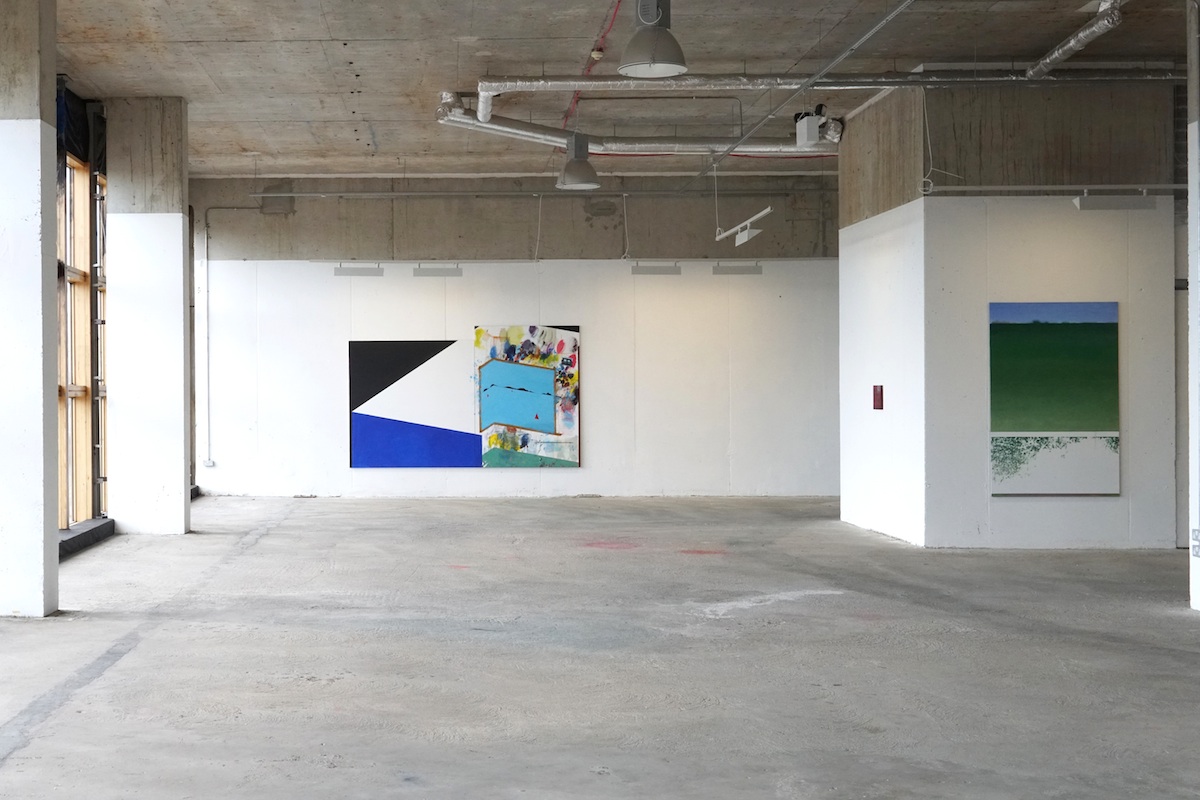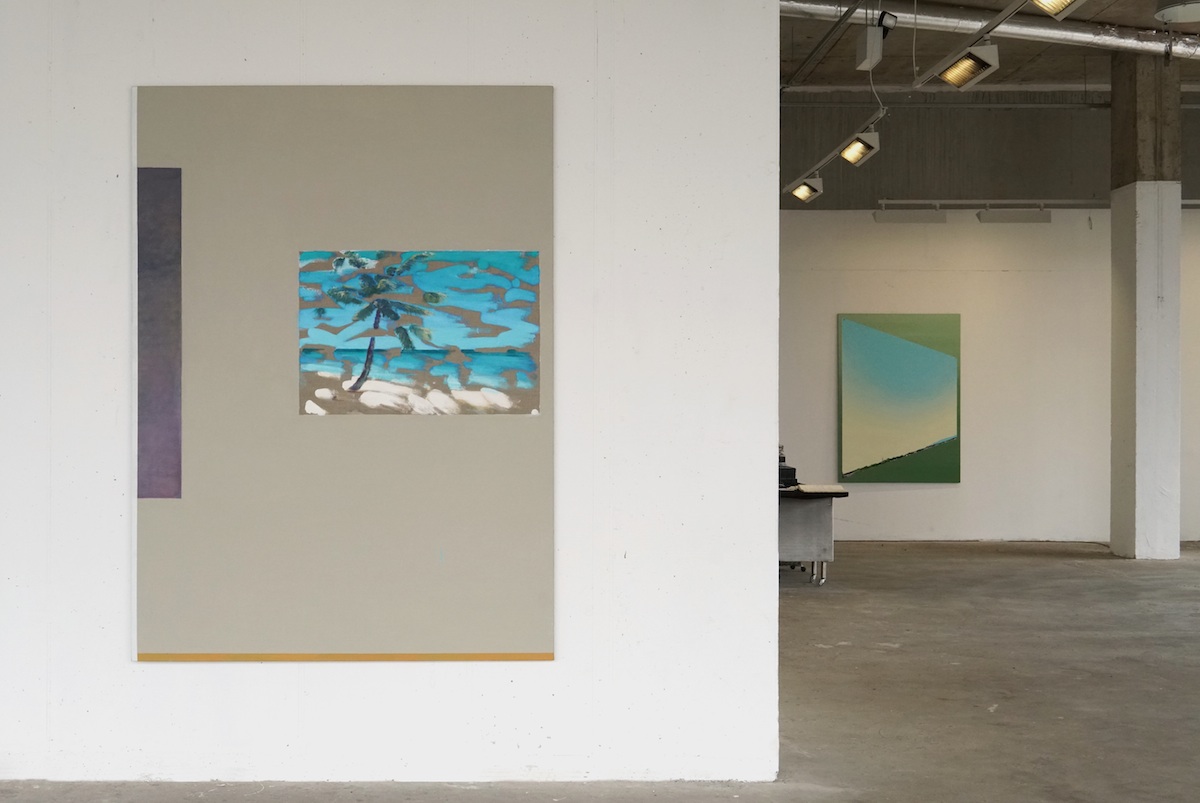Ramon Kassam, Study for a Studio by the Sea
Green on Red Gallery, Dublin, 13 April – 2 June 2018
‘Studying’ involves not only becoming familiar with the theory and knowledge that constitutes a particular subject, but also requires the concision of such knowledge towards particular – hopefully applicable – conclusions in that field. Not the most pleasant description, but an apt one when applied through the lens of 20th century canonical painting and the aesthetic progressivism therein. Ramon Kassam is no such student of lofty formalist ideals. Rather he seems to interpret 20th century painting in line with a neo-expressionist freedom that includes – yet exceeds – modernity’s formal conclusions.
It is perhaps more helpful then to consider Study for a Studio by the Sea – the Limerick painter’s latest body of work on show at Green on Red Gallery – as a study in reverse. Sidestepping conclusion, it quietly probes its starting point – the subject of landscape painting – through a plethora of modernist painting phrases that end up putting the trope through the ringer and leaving even modest assumptions about its motifs up for grabs.It unfolds as a sort of irony-struck and lyrical ode to landscape painting and to the landscape of painting. If you imagine the genre to be some stuffy old socialite throwing a shindig, this is a body of work that slept in, skipped breakfast, misread the directions, took a wrong turn, completely missed the party, and ended up in farmland with only the vistas and the smell of salt water on a westerly breeze for company. A long stare into the (Junge) Wild(e).
Composed of some nine paintings, the show is installed sparsely around Green on Red’s raw industrial walls and pillars. As the exhibition’s title would suggest, the view from the artist’s studio is the framing device for these landscapes, and the galleries own frontal window view out onto the transient footfall of Spencer Dock is at the very least complementary.
Presented as a diptych, the title painting Study for a Studio by the Sea easily constitutes a point of coalescence for the rest of the works. Whether it’s an epilogue though, or as the artist suggests, ‘a jumping-off point’, isn’t nearly as clear. It, like many of the paintings featured, boasts eccentric geometries within playful architectures, and employs fluctuating degrees of resemblance. The left panel sees simple forms scored with a limited and cool palette that at times appear like some idealised geometry within the artist’s studio, and at others like generic nautical motifs that sail a waking dream. The other far busier panel tells the story of a view from the artist’s studio wall, in which an acutely angled yet charming window frames a pale blue confusion of sky and sea. Playful floating red sails delimit the horizon and beach the scene in resemblance.
There is a level of sought detachment between Kassam and his work. From canvas to canvas perspectives constantly shift, and a sense of deliberate ellipsis in the process leads to an indeterminacy of gaze. In paintings like Study for a Studio by the Sea and Night to Day (Studio Edit), it is a slight elevation that secures this contested gaze. In Night Painter, the shift is far more allegorical, as the artist views his own studio as the midnight oil is burnt. In some of the medium-sized canvases like View, the perspective is engaged with head-on sangfroid, and a far subtler and melancholic detachment occurs. In Tropical Strokes, a stretch of grey hosts a gnarled, torn and entropic image of a picturesque tropical beach scene, palm tree and all. Creeping peripheral forms create borders, arresting any sense of pure abstracted suspension and ushering the viewer back inside the studio. Here a romantic stammering and vibrato in the marks present verisimilitude outside the gaze, as if a single scene were viewed from a hundred different perspectives in a shared instant always already passed. The show is thoroughly anchored to this positionless position.
Meta-games and distancing is not a new development in Kassam’s practice, but what is (as far as I’ve seen), is the approach to surfacing canvases so opaquely. The semi-transparent surfaces of Kassam’s previous work have hardened and condensed into staunch horizons and gradients. If his previous paintings might have suggested mischievous and expressive autobiography, then these evoke a romantic yet measured acuity. These are canvases treated with care, with every inch of linen consolidated.
Within the show, there is a second presentation called His Painting Landscape (bitter rivals) that consists of two additional paintings by Kassam’s colleagues, Sean Guinan and Fiona Burke. The inclusion of this faux melodrama further embellishes the psychology around the landscape of painting as a practice, providing a conversational thread very much posited towards the ‘scene’ as a context and condition of production.
Between this simple additional gesture and the indeterminacy in the shifting perspectives at play, there are aesthetic and conceptual reflections that linger, and the parting impressions I had of it made for some nice residual company as I walked the quays back into the city proper. Should you miss the hide-and-seek of the gaze inherent in Study for a Studio by the Sea you might be forgiven for thinking Kassam has started playing it safe, but I suspect he’s only getting started.



